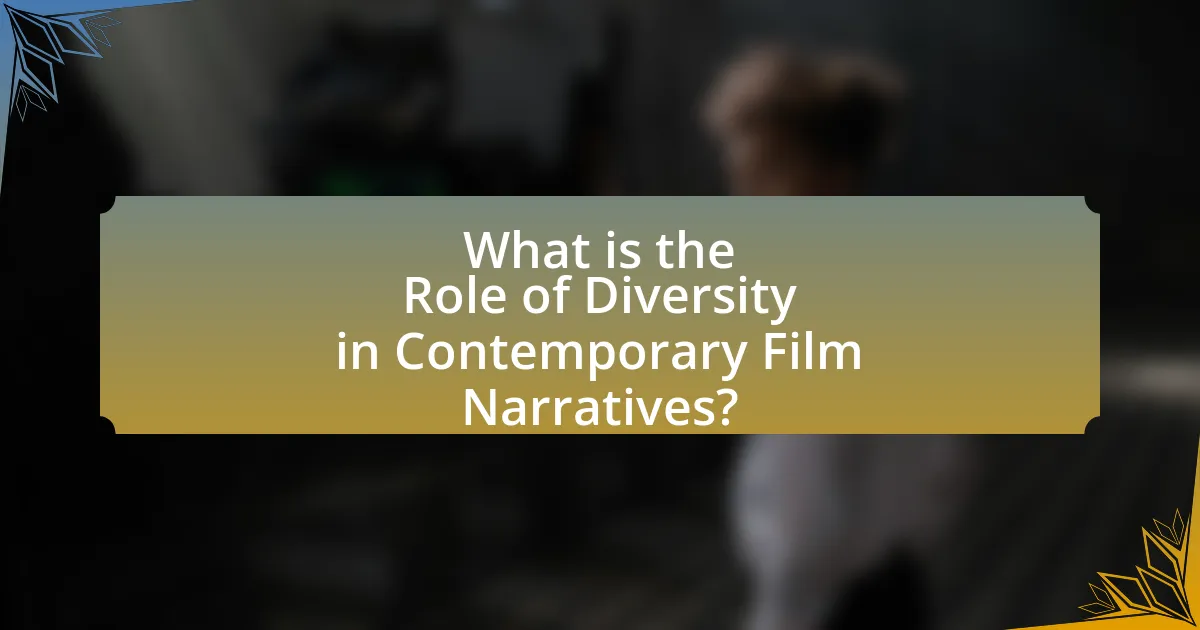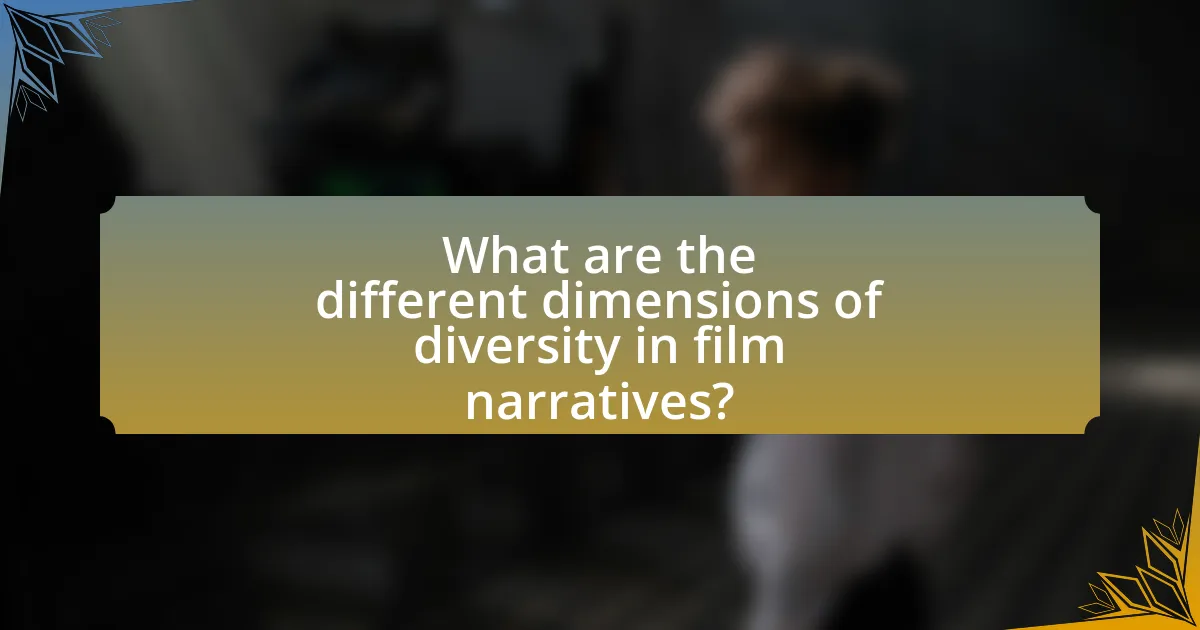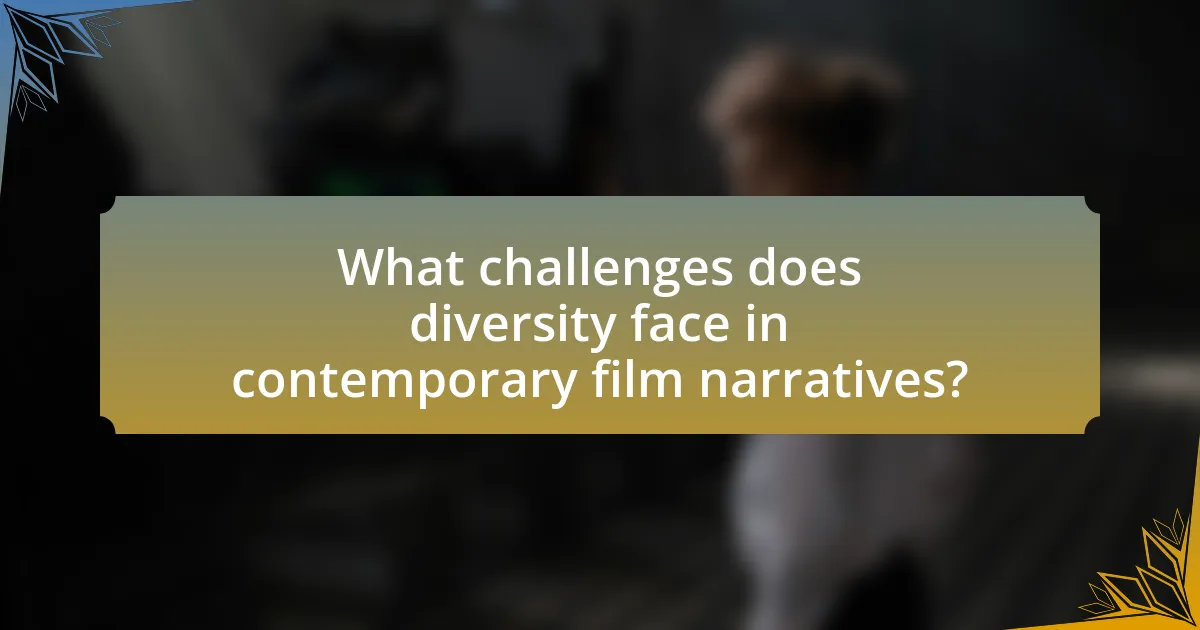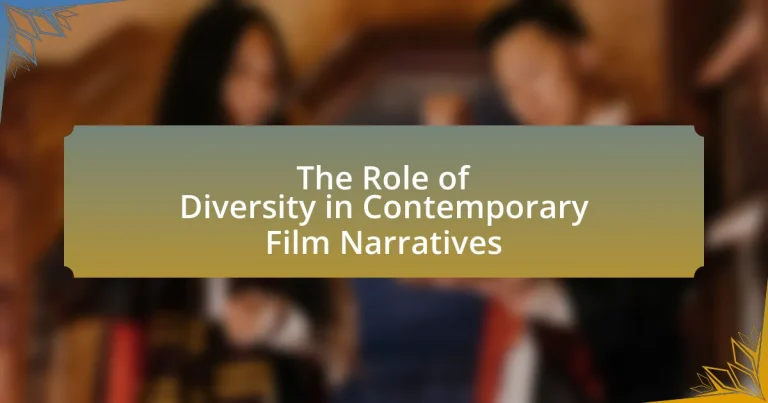The article examines the role of diversity in contemporary film narratives, highlighting its significance in enriching storytelling and reflecting the complexities of modern society. It discusses the evolution of diversity from predominantly white, male-centric narratives to a broader representation of various races, genders, and identities, driven by societal changes and audience demand. Key factors influencing this shift include historical movements, cultural shifts, and industry initiatives aimed at promoting inclusivity. The article also addresses the challenges diversity faces in film, such as stereotyping and underrepresentation, while outlining strategies for filmmakers to ensure authentic representation and the importance of audience support for diverse narratives.

What is the Role of Diversity in Contemporary Film Narratives?
Diversity plays a crucial role in contemporary film narratives by enriching storytelling and reflecting the complexities of modern society. It allows for a broader range of perspectives, experiences, and cultural backgrounds, which enhances character development and plot depth. For instance, films like “Black Panther” and “Crazy Rich Asians” have demonstrated that diverse narratives can achieve significant box office success while resonating with audiences globally. According to a study by the Annenberg Inclusion Initiative, films with diverse casts and crews tend to perform better financially, indicating that diversity not only enriches narratives but also contributes to commercial viability.
How has the concept of diversity evolved in film narratives?
The concept of diversity in film narratives has evolved from predominantly white, male-centric stories to a broader representation of various races, genders, sexual orientations, and abilities. Historically, films often marginalized or excluded minority groups, but recent decades have seen a significant shift towards inclusivity, driven by societal changes and audience demand for authentic representation. For instance, the success of films like “Black Panther” and “Crazy Rich Asians” demonstrates the commercial viability of diverse narratives, leading to increased investment in stories that reflect a wider array of human experiences. Additionally, industry initiatives, such as the inclusion rider and diversity quotas, have further propelled this evolution, ensuring that diverse voices are not only included but also hold creative power in storytelling.
What historical factors have influenced the representation of diversity in films?
Historical factors that have influenced the representation of diversity in films include social movements, legislative changes, and cultural shifts. The civil rights movement in the 1960s, for example, led to increased awareness and demand for representation of African Americans in film, resulting in more diverse storytelling. Additionally, the introduction of affirmative action policies in the 1970s encouraged the hiring of minority actors and filmmakers, further diversifying film narratives. The rise of globalization and the internet in the late 20th and early 21st centuries also expanded access to diverse stories and perspectives, allowing for a broader range of voices in cinema. These factors collectively shaped the evolving landscape of film representation, reflecting societal changes and the push for inclusivity.
How do cultural shifts impact the portrayal of diverse characters?
Cultural shifts significantly impact the portrayal of diverse characters by influencing societal norms and expectations regarding representation. As cultural attitudes evolve, filmmakers increasingly prioritize authentic and nuanced depictions of various identities, reflecting a broader understanding of diversity. For instance, the rise of the Black Lives Matter movement has led to more complex portrayals of Black characters in film, moving away from stereotypes to showcase their multifaceted experiences. This shift is supported by data indicating that films with diverse casts tend to perform better at the box office, as seen in the success of movies like “Black Panther,” which grossed over $1.3 billion globally. Such evidence underscores the importance of cultural shifts in shaping the narratives and visibility of diverse characters in contemporary cinema.
Why is diversity important in contemporary film narratives?
Diversity is important in contemporary film narratives because it reflects the multifaceted nature of society and enhances storytelling by incorporating varied perspectives. This inclusion allows for richer character development and more relatable plots, which resonate with a broader audience. Research indicates that films with diverse casts and narratives perform better at the box office, as seen in the success of movies like “Black Panther,” which grossed over $1.3 billion globally, showcasing the commercial viability of diversity in film. Furthermore, diverse narratives challenge stereotypes and promote social change, fostering empathy and understanding among viewers.
What are the social implications of diverse representation in films?
Diverse representation in films has significant social implications, including the promotion of inclusivity and the challenge of stereotypes. When films feature a variety of characters from different backgrounds, they reflect the real-world diversity of society, fostering a sense of belonging among underrepresented groups. This representation can lead to increased visibility and understanding, which helps combat prejudice and discrimination. For instance, a study by the University of Southern California’s Annenberg Inclusion Initiative found that films with diverse casts tend to perform better at the box office, indicating that audiences value and support inclusive storytelling. Furthermore, diverse representation can influence societal norms and attitudes, encouraging acceptance and empathy towards different cultures and experiences.
How does diversity enhance storytelling and audience engagement?
Diversity enhances storytelling and audience engagement by introducing a variety of perspectives and experiences that resonate with a broader audience. When narratives incorporate diverse characters and cultural contexts, they reflect the complexity of real-world experiences, making stories more relatable and engaging for viewers from different backgrounds. Research indicates that films with diverse casts and narratives tend to perform better at the box office, as they attract a wider demographic. For instance, a study by the USC Annenberg Inclusion Initiative found that films with diverse representation not only garnered higher audience ratings but also achieved greater financial success, demonstrating that diversity is a key factor in enhancing both storytelling depth and audience connection.

What are the different dimensions of diversity in film narratives?
The different dimensions of diversity in film narratives include race, gender, sexual orientation, age, ability, and cultural background. These dimensions shape character development, plotlines, and audience representation, contributing to a more inclusive storytelling landscape. For instance, films like “Black Panther” highlight racial diversity by centering Black characters and culture, while “Moonlight” explores sexual orientation and identity, showcasing the experiences of a Black gay man. Research indicates that diverse narratives can enhance audience engagement and empathy, as seen in studies by the Geena Davis Institute on Gender in Media, which found that films with diverse casts perform better at the box office.
What types of diversity are commonly represented in films?
Films commonly represent several types of diversity, including racial and ethnic diversity, gender diversity, sexual orientation diversity, age diversity, and disability representation. Racial and ethnic diversity is often showcased through characters from various backgrounds, reflecting the multicultural nature of society; for instance, films like “Black Panther” highlight African culture and representation. Gender diversity is increasingly visible, with strong female leads in movies such as “Wonder Woman,” which challenges traditional gender roles. Sexual orientation diversity is represented through LGBTQ+ characters and narratives, as seen in films like “Moonlight,” which won the Academy Award for Best Picture in 2017. Age diversity is also present, with stories featuring characters of different ages, such as “The Intern,” which explores intergenerational relationships. Lastly, disability representation is gaining traction, with films like “A Quiet Place” showcasing characters with disabilities in significant roles. These diverse representations contribute to a more inclusive film landscape, reflecting the complexities of real-world experiences.
How do racial and ethnic diversities manifest in contemporary films?
Racial and ethnic diversities manifest in contemporary films through representation in casting, storytelling, and production roles. Films increasingly feature diverse characters and narratives that reflect the experiences of various racial and ethnic groups, moving beyond stereotypes to portray complex, authentic stories. For instance, the success of films like “Black Panther” and “Crazy Rich Asians” demonstrates how diverse casts can resonate with audiences, achieving both critical acclaim and box office success. Additionally, the inclusion of diverse filmmakers and writers contributes to a broader range of perspectives, enriching the cinematic landscape and challenging traditional narratives. This shift is supported by industry initiatives aimed at increasing diversity, such as the Academy of Motion Picture Arts and Sciences’ inclusion standards for Best Picture eligibility, which emphasize the importance of representation in film.
What role does gender diversity play in film narratives?
Gender diversity plays a crucial role in film narratives by enriching storytelling and broadening perspectives. Films that incorporate diverse gender representations often reflect more authentic human experiences, allowing for a wider range of character development and plotlines. Research indicates that gender-diverse films tend to resonate more with audiences, as they can relate to varied experiences and viewpoints. For instance, a study by the Geena Davis Institute on Gender in Media found that films with balanced gender representation perform better at the box office, highlighting the commercial viability of gender diversity in storytelling. This evidence underscores the importance of gender diversity in creating compelling and relatable narratives in contemporary cinema.
How do filmmakers approach diversity in their storytelling?
Filmmakers approach diversity in their storytelling by intentionally incorporating a range of perspectives, cultures, and experiences to create more authentic narratives. This approach often involves casting actors from diverse backgrounds, collaborating with writers and directors who represent various identities, and addressing themes that resonate with underrepresented communities. For instance, the success of films like “Black Panther” and “Crazy Rich Asians” demonstrates how diverse storytelling can lead to both critical acclaim and commercial success, highlighting the demand for representation in cinema. Additionally, studies indicate that films with diverse casts and narratives tend to perform better at the box office, reflecting audience preferences for inclusive content.
What strategies do filmmakers use to ensure authentic representation?
Filmmakers use several strategies to ensure authentic representation, including collaboration with diverse writers and consultants, casting actors who reflect the characters’ backgrounds, and conducting thorough research on cultural contexts. By involving individuals from the communities being portrayed, filmmakers can gain insights that enhance the accuracy and depth of their narratives. For instance, films like “Black Panther” featured a predominantly Black cast and consulted cultural experts to authentically represent African cultures, which contributed to its critical acclaim and cultural significance. This approach not only fosters authenticity but also promotes inclusivity in storytelling.
How do collaborations with diverse creators influence film narratives?
Collaborations with diverse creators significantly enrich film narratives by introducing varied perspectives and cultural contexts. This diversity fosters authenticity and relatability, allowing stories to resonate with a broader audience. For instance, films like “Black Panther,” which involved a predominantly Black cast and crew, showcased African culture and experiences, leading to a deeper understanding and appreciation among viewers. Research indicates that diverse teams produce more innovative content, as highlighted in a McKinsey report, which found that companies with diverse leadership are 35% more likely to outperform their peers in profitability. Thus, the inclusion of diverse creators not only enhances narrative depth but also drives commercial success.

What challenges does diversity face in contemporary film narratives?
Diversity in contemporary film narratives faces significant challenges, primarily including stereotyping, underrepresentation, and lack of authentic storytelling. Stereotyping occurs when characters from diverse backgrounds are portrayed through narrow, often negative lenses, limiting audience perceptions and reinforcing biases. Underrepresentation is evident in the disproportionate number of roles available to actors from diverse backgrounds, as studies show that films with predominantly white casts dominate box office success, marginalizing diverse voices. Furthermore, the lack of authentic storytelling arises when narratives are crafted without genuine input from the communities they depict, leading to inaccuracies and cultural misrepresentation. For instance, a report by the Annenberg Inclusion Initiative highlights that only 28.3% of speaking characters in films are from underrepresented racial/ethnic groups, underscoring the systemic barriers that diversity faces in the industry.
What barriers exist to achieving true diversity in film?
Barriers to achieving true diversity in film include systemic biases, lack of access to funding, and limited representation in decision-making roles. Systemic biases manifest in hiring practices that favor established networks, often sidelining diverse talent. Additionally, the film industry frequently relies on traditional funding sources that may prioritize projects with familiar narratives, limiting opportunities for diverse stories. Furthermore, the underrepresentation of diverse voices in executive positions restricts the influence of varied perspectives in storytelling, as evidenced by studies showing that films produced by diverse teams are more likely to feature inclusive narratives.
How do industry practices hinder diverse representation?
Industry practices hinder diverse representation by perpetuating stereotypes and limiting opportunities for underrepresented groups. For instance, casting decisions often favor established stars over diverse talent, which restricts the visibility of actors from various backgrounds. Additionally, funding and distribution models frequently prioritize projects that align with mainstream narratives, sidelining stories that reflect diverse experiences. According to a 2021 study by the Annenberg Inclusion Initiative, only 31.4% of film leads were from underrepresented racial and ethnic groups, highlighting the systemic barriers that exist. These practices create an environment where diverse voices struggle to gain traction, ultimately affecting the richness of contemporary film narratives.
What are the consequences of tokenism in film narratives?
Tokenism in film narratives leads to superficial representation, which undermines the authenticity of characters and stories. This practice often results in marginalized groups being portrayed in a one-dimensional manner, failing to reflect their true diversity and complexity. For instance, a study by the Geena Davis Institute on Gender in Media found that films with token characters often perpetuate stereotypes rather than challenge them, limiting the audience’s understanding of those cultures. Consequently, tokenism can alienate viewers from underrepresented communities, as they may feel misrepresented or excluded from narratives that do not accurately depict their experiences.
How can the film industry overcome these challenges?
The film industry can overcome challenges related to diversity by implementing inclusive hiring practices and promoting diverse storytelling. By actively recruiting talent from underrepresented communities, the industry can ensure a broader range of perspectives in both front-of-camera and behind-the-scenes roles. For instance, a study by the USC Annenberg Inclusion Initiative found that films with diverse casts and crews tend to perform better at the box office, indicating that diversity not only enriches narratives but also drives financial success. Additionally, fostering partnerships with organizations that advocate for diversity can help create pathways for emerging filmmakers from marginalized backgrounds, further enhancing the industry’s commitment to inclusivity.
What initiatives are being implemented to promote diversity in film?
Initiatives promoting diversity in film include the establishment of diversity quotas, funding programs for underrepresented filmmakers, and partnerships with organizations advocating for inclusion. For instance, the Academy of Motion Picture Arts and Sciences has implemented the “Academy Aperture 2025” initiative, which aims to increase representation among its members and in the films it recognizes. Additionally, the Sundance Institute offers grants and mentorship programs specifically for filmmakers from marginalized communities, supporting diverse storytelling. These initiatives are backed by research indicating that diverse films not only reflect societal realities but also achieve greater box office success, as seen in the success of films like “Black Panther,” which grossed over $1.3 billion globally.
How can audiences support diverse narratives in cinema?
Audiences can support diverse narratives in cinema by actively choosing to watch films that feature underrepresented voices and stories. By purchasing tickets, streaming, and promoting these films on social media, viewers contribute to their financial success and visibility. Research indicates that films with diverse casts and narratives often perform well at the box office, as seen with movies like “Black Panther,” which grossed over $1.3 billion globally, demonstrating that audiences are eager for varied storytelling. Additionally, engaging in discussions about these films and advocating for their inclusion in mainstream platforms further amplifies their reach and impact.
What are best practices for promoting diversity in film narratives?
Best practices for promoting diversity in film narratives include incorporating authentic representation, engaging diverse voices in storytelling, and prioritizing intersectionality. Authentic representation ensures that characters reflect the complexities of real-life experiences, which can be achieved by hiring writers, directors, and actors from varied backgrounds. Engaging diverse voices in storytelling allows for a broader range of perspectives and experiences, enriching the narrative. Prioritizing intersectionality acknowledges that individuals have multiple identities that intersect, leading to unique experiences that should be reflected in film narratives. Research by the Annenberg Inclusion Initiative found that films with diverse casts and crews tend to perform better at the box office, highlighting the commercial viability of diversity in storytelling.


